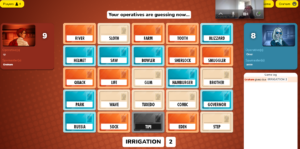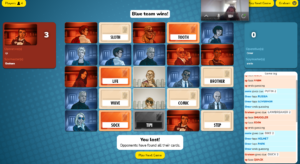Codenames is a team-based word guessing game with asymmetric information. The playspace consists of a board of 25 words, some of which are assigned to a Red team, some of which are assigned to a Blue team, some of which are neutral, and one of which is a Bomb. Each team has a Spymaster, (who can see the identity of all the words) whose job is to give clues to the other members of their team (called Operatives, and who cannot see the words’ identities) so that they identify their team’s words before the other team does. There are very tight constraints on the kinds of clues the Spymaster can give: each turn they can say only one word (which can’t itself be a word on the board) and a number. It’s up to the operatives to try to deduce which word(s) on the board the Spymaster is referring to. If they guess the Bomb word, their team loses on the spot. Our proposed game sort of plays like an inverted Codenames, where the objective is to use your words without making it obvious to the other players.

One of the strong points of Codenames is its theming. The game is pitched as a secret communication between an elite team of spies, and the graphics and naming tie into this image: pictures of sleek-looking agents cover up each of the guessed words. This ties into one of the main sources of fun promised to the player: the fantasy of being a secret agent. Even the extremely restrictive nature of the clues ties into this: one can imagine that the Spymaster doesn’t want to let slip too much information about their agents’ cover identities!

The other source of fun I suspect Codenames is going for is fellowship. It is a team-based game reliant on careful cooperation, so it’s easy to expect that the wining team feels a sense of closeness. However, this type of fun is undercut fairly heavily when there are only two players per team (as there were in my play session). In such a case, it means there is only one Spymaster and one Operative. Since the Spymaster isn’t allowed to communicate with the operative outside of the prescribed clue-giving interface (since that could allow for additional, even potentially nonverbal, communication), the opportunities for feeling fellowship with your teammate are actually quite rare. This certainly didn’t sink the experience as a whole, but it definitely feels like a weak point in its design.
Finally, there aren’t any specific protections in Codenames against abuse. The primary way to communicate with other players is through single-word clues from the Spymaster, but theoretically the Spymaster could still abuse their position by sending useless or obscene clues. In some online versions there is a dedicated chat between Spymasters, which could help alleviate instances of unintentional abuse by checking beforehand, but it wouldn’t help with cases of intentional abuse.


